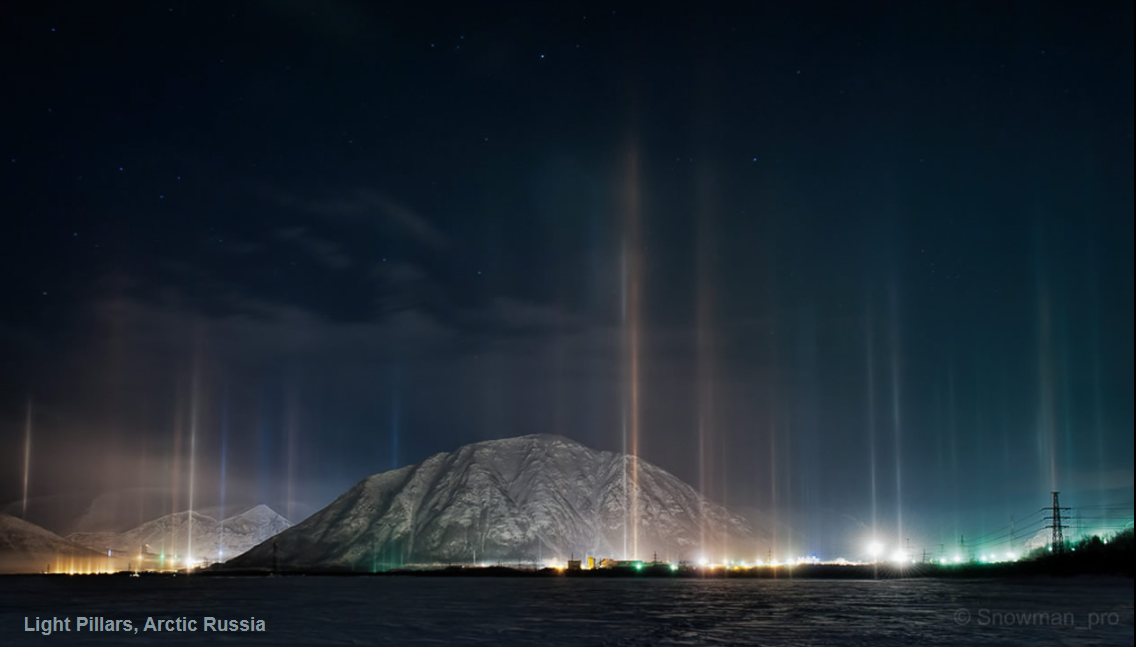Light Pillars, Arctic Russia - OPOD
Light Pillars: A Mesmerizing Atmospheric Phenomenon in Arctic Russia
Have you ever witnessed a mesmerizing display of light pillars piercing the night sky? One such enchanting sight can be found in Arctic Russia, specifically in the Kola Peninsula. This region is home to Mount Yukspor in the Khibiny Massif, where nature's magic unfolds with hexagonal plate crystals suspended in the subzero air, creating an illusion of upward pillars of light.
The Illusion of Light Pillars
When temperatures drop to subzero levels, hexagonal plate crystals float gently through the atmosphere. These tiny ice crystals act as prisms, bending and reflecting light in fascinating ways. As these crystals drift, they intercept the distant ground lights and redirect them towards the observer's eye and camera lens. The collective glints of these crystals create an extraordinary visual phenomenon that appears as pillars of light reaching towards the heavens.
The Mechanics Behind Light Pillars
To understand how light pillars form, imagine standing on the ground and observing a distant light source, such as streetlights or the lights from a cityscape. The hexagonal plate crystals responsible for light pillars are positioned approximately halfway between the ground lights and the observer's eye. As light passes through these crystals, it undergoes refraction and reflection, causing it to scatter in different directions. This scattering of light is what gives rise to the vertical columns of luminosity that seem to stretch infinitely upward.
Captivating Images of Arctic Light Pillars
Photographer Boris Borisovich has beautifully captured the ethereal beauty of light pillars in Arctic Russia. His images showcase the stunning visual spectacle created by these hexagonal plate crystals. By skillfully framing Mount Yukspor in the Khibiny Massif as the central backdrop, Borisovich allows us to witness the awe-inspiring combination of natural elements at play.
Experiencing the Wonder of Light Pillars
Witnessing light pillars firsthand is an experience that will leave you in awe of the natural world's capacity to astound. If you find yourself in Arctic Russia during the winter months, keep an eye out for these captivating phenomena. Seek out areas with minimal light pollution, as this will enhance your chances of spotting light pillars. Patience is key, as these phenomena are not always present and can be fleeting. However, when you are fortunate enough to witness the dance of light pillars against the night sky, it is a sight you will never forget.
Exploring the Science of Atmospheric Optics
Light pillars are just one example of the many intriguing phenomena that fall under the field of atmospheric optics. This branch of science focuses on the study of how light interacts with various atmospheric elements, such as ice crystals, water droplets, and dust particles. By understanding the principles behind these interactions, scientists can explain and predict the occurrence of stunning visual displays like light pillars.
Unraveling the Mysteries of Hexagonal Plate Crystals
Hexagonal plate crystals play a crucial role in the formation of light pillars. These delicate ice crystals have a hexagonal shape and are typically flat and thin. The unique geometry of these crystals allows them to act as tiny prisms, bending and refracting light in specific ways. Scientists continue to study the intricate structure and behavior of hexagonal plate crystals to gain deeper insights into the mechanisms behind atmospheric optics phenomena.
The Magic of Arctic Russia's Atmospheric Wonders
Arctic Russia is renowned for its breathtaking natural beauty, and the presence of light pillars adds yet another layer of magic to this already captivating landscape. The juxtaposition of these luminous columns against the stark Arctic wilderness creates a scene that is both awe-inspiring and ethereal. Whether you are a seasoned photographer or simply a lover of nature's wonders, witnessing light pillars in Arctic Russia is an experience that will forever be etched in your memory.
Conclusion
Light pillars in Arctic Russia are a testament to the marvels of atmospheric optics. The interplay between hexagonal plate crystals, distant ground lights, and the observer's perspective creates a spectacle that defies explanation. Whether you have the opportunity to witness these captivating phenomena firsthand or can only admire them through the lens of a talented photographer like Boris Borisovich, light pillars serve as a reminder of the boundless beauty and mystery that exists within our natural world. So, keep your eyes peeled and your sense of wonder alive as you embark on your own journey to discover the enchanting phenomena of atmospheric optics.

Light Pillars, Arctic Russia
Image by Boris Borisovich ( journal) on the Kola Peninsula. Mount Yukspor in the Khibiny Massif is central.
Hexagonal plate crystals drifting in the subzero air reflect the distant ground lights towards the eye and camera. Their collective glints give the illusion of upward pillars of light.
The crystals generating the 'pillars' are approximately mid way between the ground light and the eye.
Image ©Boris Borisovich, shown with permission

Note: this article has been automatically converted from the old site and may not appear as intended. You can find the original article here.
Reference Atmospheric Optics
If you use any of the definitions, information, or data presented on Atmospheric Optics, please copy the link or reference below to properly credit us as the reference source. Thank you!
-
<a href="https://atoptics.co.uk/blog/light-pillars-arctic-russia-opod/">Light Pillars, Arctic Russia - OPOD</a>
-
"Light Pillars, Arctic Russia - OPOD". Atmospheric Optics. Accessed on November 26, 2024. https://atoptics.co.uk/blog/light-pillars-arctic-russia-opod/.
-
"Light Pillars, Arctic Russia - OPOD". Atmospheric Optics, https://atoptics.co.uk/blog/light-pillars-arctic-russia-opod/. Accessed 26 November, 2024
-
Light Pillars, Arctic Russia - OPOD. Atmospheric Optics. Retrieved from https://atoptics.co.uk/blog/light-pillars-arctic-russia-opod/.